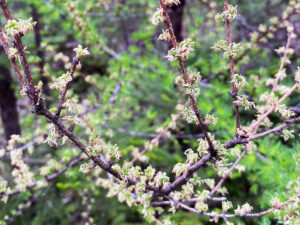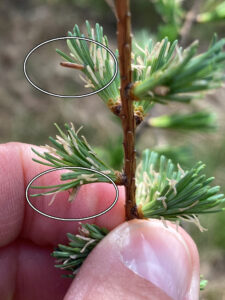
Severe defoliation of a tamarack tree by larch casebearer shows most needles mined out by the larvae. / Photo Credit: Linda Williams, Wisconsin DNR
By Linda Williams, DNR Forest Health Specialist, Woodruff
Linda.Williams@wisconsin.gov or 920-360-0665
If you’ve noticed tamarack trees with tan or light-brown foliage, you’re probably seeing the work of the larch casebearer.
As foliage began to expand this spring, the caterpillars of this invasive moth became active and began to feed. The tiny caterpillars mine out the needles of tamarack and use them as “cases” to protect themselves, hence their name.
Looking closely at damaged needles, you will see some tan, cigar-shaped objects. By looking even more closely, you may see the head and legs of the tiny caterpillar sticking out of one end as they feed on needles.

Larch casebearer larvae look like small tan sticks or cigars attached to needles. Pale spots on needles are where casebearers have eaten the insides of the needle.
Photo credit: Linda Williams, Wisconsin DNR.
Larch casebearer caterpillars overwinter as young caterpillars and start feeding as soon as the weather warms up in the spring and buds start to break. Tamarack with moderate to heavy defoliation will produce a second set of needles, usually by mid-July.
Larch casebearers pupate within their cases, attached firmly to needles or twigs on the tree in early summer. Adults emerge, mate and lay eggs, which hatch in early fall. At that time, they do some feeding to prepare for winter. So, some light needle browning may occur in early fall, which can easily be mistaken for spider mite damage.
Repeated defoliation of tamarack can weaken the trees, making them more susceptible to attack by eastern larch beetle, which feeds beneath the bark and girdles the tree, causing mortality.
Larch casebearer populations are usually controlled by parasitoids, predators and abiotic factors such as late frosts. Management is not usually recommended in forest stands. Insecticides should be used only to protect high-value ornamental trees.
